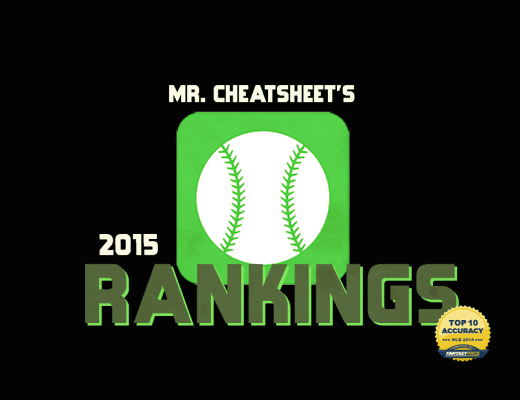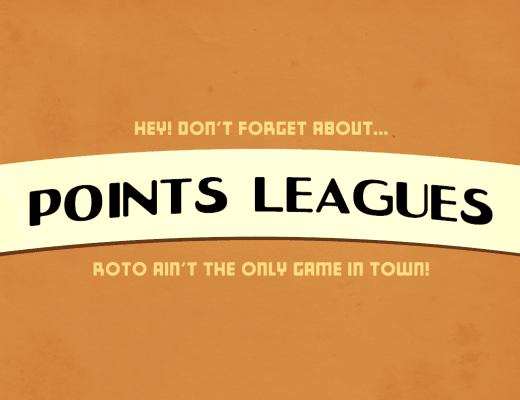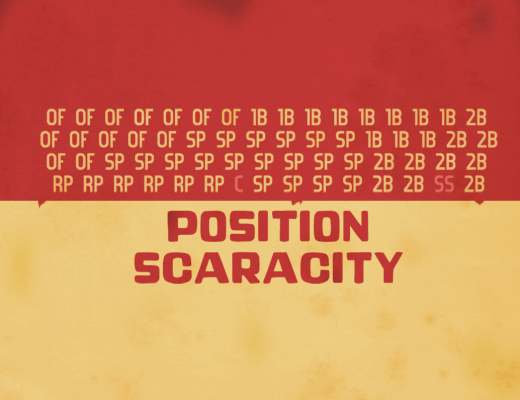The first step in going from fantasy newbie to becoming an advanced fantasy baseball player is to realize that last year’s stats cannot be fully trusted. When you come to recognize that luck is a part of the game of baseball, you unearth a whole different side of the game and unlock all of the fun statistics that can help you realize how lucky or unlucky a player was in a given year. Earlier this week, I looked at where luck may have played a role in some home run totals from 2014 but now let’s look some of the fluky batting averages from last year.
As we know, AVG is determined by the number of times a batter gets a hit when they’re at the plate. A player can end up having a lot of lucky hits throughout a year which can pad that stat and, thus, Batting Average On Balls In Play (BABIP) is a stat that was created to help determine who is getting lucky by creating more hits than normal. The journey of finding out whether a player got a lot of lucky hits doesn’t stop there though. Let’s look at the three main statistics that can help us out in this department:
- BABIP – This is a player’s batting average on all balls hit into the field of play. The league average BABIP is typically around .290 so the assumption is that players who have a higher BABIP than .290 are getting more hits on balls in play than they should be getting.
- xBABIP – However, a player can control his BABIP by the types of balls he hits (line drives create more hits for example) and how speedy he is (faster players generate more hits on batted balls). Their expected BABIP may be quite different than the league average of .290. We can calculate a player’s expected BABIP by looking at their batted ball profile.
- xAVG – Taking that player’s xBABIP, we can then calculate their expected AVG in a season. Comparing this to their actual AVG lets us know exactly how lucky each batter was.
If you’re interested in learning more about these stats, I’ve got a more thorough write-up in an old post of mine here. But, without further ado, let’s see some of the more glaring differences between AVG and xAVG to see guys who had an uncharacteristic year last season.
Players Due For A Decline In AVG
Of the 10 decliners I named in last year’s blog post, 9 of them declined (damn you, Michael Cuddyer, for ruining my perfect ten!) with many of them coming eerily close to that xAVG statistic I had laid out for them. Let’s take a look at some of the players who should be taking a step back in the AVG department in 2015 and hope for the same success:
- Adam Lind (.321 AVG, .256 xAVG) – Lind has had a fairly long career and had been a .269 career hitter going into last season so it shouldn’t be a complete shock that his .321 AVG is going to be taking a major drop next year.
- Casey McGehee (.287 AVG, .227 xAVG) – McGehee had two previous seasons of hitting much closer to that .227 xAVG number and, yeah, he’ll be going back to that number in 2015 unless he can find some secret luck potion to maintain last year’s success.
- J.D. Martinez (.315 AVG, .267 xAVG) – I actually liked Martinez as a bit of a breakout player this past season and was hoping that success would continue but it looks like luck was on his side so don’t target him as a 2015 sleeper.
- Drew Stubbs (.289 AVG, .248 xAVG) – Stubby had a nice little 15 HR, 20 SB year in limited time and a had a nice AVG on top of that too. But, yeah, history reminds us that he’s still a .246 career hitter even after that fluky year and his xAVG reinforces that fact. Sorry but a sudden career breakout for Stubbs isn’t happening here.
- Michael Morse (.279 AVG, .243 xAVG) – We’re in quite a pickle now because I told you in the HR article earlier this week that Morse was unlucky in the HR department and now I’m telling you that he was lucky in the AVG department. Despite his fluky AVG compared to his xAVG, he’s still a .281 career hitter so it’ll be interesting to see if his AVG truly will be on the decline.
- Conor Gillaspie (.282 AVG, .249 xAVG) – Gillaspie is an interesting fantasy player as he’s a medium-power hitter (10-15 HR) without any speed and hasn’t shown an ability to hit for much AVG. So, he has no great fantasy skills except for the fact that he had a decent AVG last year but, um, yeah… you know why he’s on this list… So, yeah, he’s totally not a fantasy player you should really have on your roster.
- Jose Altuve (.341 AVG, .308 xAVG) – Altuve carried a couple of my fantasy teams last year with his tremendous season. Expecting him to hit .341 again is a bit far-fetched but, really, if he falls back to his .308 xAVG number instead then that’s certainly not bad.
- Matt Joyce (.254 AVG, .221 xAVG) – Matt Joyce always seems to end up on a roster or two of mine for a couple weeks during the year. It’ll probably happen again despite him being kind of a hot mess in the AVG department
- Giancarlo Stanton (.288 AVG, .256 xAVG) – Stanton had a monster year last year after a somewhat disappointing 2013 season but unfortunately he may be due to at least take a small step back next year (as far as AVG is concerned at least). Keep this in mind when you’re weighing your early draft options.
- Danny Santana (.319 AVG, .288 xAVG) – Like Altuve, Santana helped a couple of my teams as a nice mid-season pickup last year. Alas, it looks like he’ll have to rely on Lady Luck to be able to repeat that surprise performance. He’s still a cheap source of SB’s and if he regresses to a .288 AVG then that’s not really so bad depending on his price tag.
Players Due For An Increase In AVG
Despite how successful I was at picking players who would have a drop in AVG last year, picking those that are due to have an increase in AVG proved to be much tougher. Last year’s picks were a mixed bag with some rising up to the expected levels but others not quite as lucky. As a result, I’m going to limit my list here to less players but those that seem to be more of a sure thing for a bit of a rebound.
- Chris Davis (.196 AVG, .241 xAVG) – Oh, last year was quite disappointing for Chris Davis fans. His AVG and power numbers took quite a fall. He had hit .270 and .286 in his previous seasons but then dropped to .196 last year. While he should definitely rebound a bit from that, it may not reach those previous levels as his xAVG still only had him at .241. So, expect a bit of a comeback but don’t expect 2013 Chris Davis again.
- Brian McCann (.232 AVG, .276 xAVG) – Sure, McCann is no longer a .300 hitter at this point in his career but we can at least be happy that he’s not quite the .232 hitter we saw last year either. His power was still there, which is good, and we should see a rebound in his AVG so he might be a good buy-low candidate in 2015.
- Jean Segura (.246 AVG, .285 xAVG) – Segura was a bit of a letdown last year (understatement, I know) but he should be in store for a rebound performance. If he can hit closer to his xAVG then we should also see more SB opportunities and Runs from him. Once again, here’s a nice buy-low candidate.
- Allen Craig (.215 AVG, .251 xAVG) – The best fantasy skill that Craig had from 2011 to 2013 was his ability to hit for a high AVG and, well, that certainly didn’t happen last year. The odd thing is that his xAVG doesn’t even compare to his old ability to hit for over .300. If he can’t hit for .300 anymore then I’m not sure what he can do for your fantasy team. Use extreme caution here.
- Jedd Gyorko (.210 AVG, .240 xAVG) – The batting average was concerning for Gyorko last year but that had never been his strong point anyway. The fact that his power disappeared is a bit more concerning. We have the good news that his AVG should return to less-terrible levels but hopefully he can rekindle his power stroke as well in 2015.
- Carlos Santana (.231 AVG, .260 xAVG) – If Santana was able to hit closer to his xAVG with the power he showed last year then he would have had quite the nice season. The fact that he’s no longer eligible at catcher does hurt his fantasy value but the idea of Santana hitting for a decent AVG with his 25-30 HR potential is certainly exciting.



